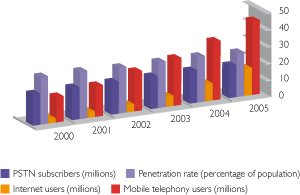Telecommunications in Turkey
| |

©ICONOTEC |
| |

©Turkish Ministry of
Culture and Tourism |
| |

©ICONOTEC |
Turkey’s telecommunication history is over a century old, with the first
telegraph line installed in 1847 and the first telephone circuit in 1881. Huge
investments were made in the 1980s and 1990s to modernize infrastructure. Today,
Turkey’s market for information and communication technologies (ICT) has high
potential, given ongoing reform of the sector and the country’s population of
more than 73 million (according to the ITU Yearbook of Statistics for 2005).
With over 19 million fixed-telephone lines, about 43.6 million mobile telephony
subscribers and an estimated 16 million internet users at the end of 2005 (see
Figure 1), there are growth opportunities in almost all spheres of ICT.
Turkey’s youthful market augments this potential. Some 50 per cent of the
population is under the age of 25, with 37 million between the ages of 15 and
44. Their influence is shown, for example, in the rising popularity of the short
message service (SMS) via mobile phones. The number of SMS messages rose from
6.3 million in 2004 to 16.73 million in 2005.
A changing landscape
|
Figure 1 — Turkish telecommunication
indicators, 2000–2005 |
|
 |
|
Since 1994, the ICT market in Turkey has been going through restructuring to
promote competition. Provision of mobile telephone services was liberalized in
that year. In 2000, the Telecommunications Authority was established as an
autonomous regulatory body. It is responsible for licensing, tariffs,
interconnection, numbering and spectrum planning and allocation. The Ministry of
Transport retains responsibility for ensuring universal service and for setting
telecommunications policy.
Privatization of the national carrier, Türk Telekom, was a key
component of the government’s policy to create a competitive ICT market
structure. January 2004 saw the end of the monopoly of Türk Telekom in
voice communication and infrastructure, and in August 2005, it was finally
privatized through the sale of 55 per cent of the company to an international
consortium, Oger Telecoms Joint Venture Group, for USD 6.5 billion.
| |
Figure 2
— Number and type of telecommunication
operators, end of 2005 |
| |
 |
Global players continue to enter the Turkish ICT market. In 2005, the
Çukurova Group sold 3.22 per cent of its shares in the mobile operator
Turkcell to a Russian firm, the Alfa Group, in a deal worth USD 3.3
billion. In December that year, Vodafone announced its purchase of the
mobile operator Telsim for USD 4.5 billion, and final approval for the
sale was given in May 2006. The number of licensed operators in Turkey has
increased dramatically, although not all have launched services. By December
2005, the Telecommunications Authority had issued licenses to over 200
operators, with most of these going to internet service providers (ISP), as
shown in Figure 2.
Mobile numbers surge
Turkey’s mobile telecommunication market has grown fast. By the end of 2005,
there were 43.6 million mobile phone subscribers, or almost 60 per cent of the
population. The expectation is that mobile subscribers will reach 51 million in
2006.
Mobile telephony was introduced in 1986, when Türk Telekom opened an
analogue NMT network. In 1994, Turkcell and Telsim launched
services in the 900 MHz band under revenue-sharing agreements with Türk
Telekom, using networks based on the global system for mobile communications
(GSM). These agreements were converted into licences in 1998. The mobile market
was further opened in 2001, when two new GSM operators introduced services in
the 1800 MHz band. These were Aria, (then jointly owned by Turkiye Is
Bankasi and Telecom Italia Mobile), and Aycell, owned by
Türk Telekom. In 2004, Aria and Aycell merged to form the new
company, Avea.

Siemens |
|
GSM subscriptions saw a sharp rise from 692 779 in 1996 to nearly 28 million
in 2003. The expansion in mobile communications continues. At the end of 2005,
Turkcell was the market leader with about 27.9 million subscribers,
Telsim had more than 9 million and Avea had an estimated 6.5 million
subscribers.
The introduction of competition in the mobile sector has forced down prices
for users, particularly since the introduction of prepaid services. However,
companies have been making less profit. While the number of subscribers to GSM
services increased by a factor of nearly 10 between 1998 and 2004, the revenues
of operators rose by a factor of 3.9. Revenue per user was USD 30-40 in 1998,
but dropped to USD 12-13 in 2004, because of increased competition and
additional tax burdens imposed after 1999. Nevertheless, further growth of the
mobile sector is expected with the anticipated sale in 2007 of licences for
third-generation (3G or IMT-2000) services. Meanwhile, applications based on
general packet radio service (GPRS, or 2.5G) technology are on offer.
Fixed lines stagnate
|
|

Siemens |
The percentage of people in Turkey subscribing to the public switched
telephone network (PSTN) was low until the 1980s, when Türk Telekom
invested in new infrastructure. This helped raise the fixed-line penetration
rate to its current level of about 26 per cent. Much of the investment has been
spent on digitizing telephone exchanges and modernizing infrastructure,
including establishing an internet backbone and the launch of three
communication satellites.
However, PSTN investment dwindled after the launch of GSM networks and mobile
services. Between 2000 and 2005, the number of subscribers to fixed-line phones
stayed about the same at some 19 million. In contrast, the number of subscribers
to mobile phone services more than doubled in the same period, from around 15
million to 43.6 million (see Figure 1).
Internet and broadband
|

Siemens |
|
When it comes to computers, ownership is relatively low in Turkey, but the
number of internet users is rising fast. Figures from the Telecommunications
Authority show a surge in numbers from 2.5 million users in 2000, to 6 million
in 2003, and 15 million in 2005 (see Figure 1).
People mainly use the internet for banking and shopping. Major government and
private-sector organizations, and many small businesses, have websites, and
business-to-business and e-government services are on the increase. Broadband
connections using asymmetric digital subscriber line (ADSL) and cable modem
technologies are available. Although the number of users is still fairly low, it
has been growing rapidly since 2004. As the internet is used more and more for
streaming media, users’ requirements for bandwidth are expected to increase
substantially.
Infrastructure for data services includes leased lines, an integrated
services digital network (ISDN), frame relay, packet switching data networks,
very small aperture terminal (VSAT) networks, time division multiplexing (TDM)
networks and asynchronous transfer mode (ATM). International connections are
provided by three submarine fibre-optic cables in the Mediterranean and the
Black Sea (linking Turkey with Italy, Greece, Israel, Bulgaria, Romania, and the
Russian Federation), via 12 Intelsat earth stations, and by 328 mobile satellite
terminals in the Inmarsat and Eutelsat systems.
|
|

PhotoDisc |
Information society strategies

Photos.com

Murat Cokal |

Olga Figurska |
|
| Turkey plans to transform
itself from a traditional economy to a knowledge economy |
|
According to the Organisation for Economic Co-operation and Development
(OECD), Turkey has the fastest growing economy among its members. However, the
Turkish Government recognizes that, in order to survive and thrive in a
globalized environment that depends on information, rapid changes are required
in organizational structures and ideas. As Turkey’s State Planning Organization
(SPO) says, these will include “the redefinition of the government’s
organization, work and decision-making processes; and development of learning
systems, technical and legal infrastructure, and economic policy tools in
accordance with the needs of the information society.”
To be successful, these efforts need coordination, SPO says, and projects
should have concrete goals and be prioritized according to the needs of society
as a whole. Thus, promoting access to ICT is listed as one of the most
significant initiatives under the “Urgent Action Plan” that has been formulated
by the Turkish Government to remedy problems in such areas as financial
stability, public management, agriculture, and manufacturing. Under the plan,
the e-Transformation Turkey Project provides a coordinating mechanism for
improving ICT, under the auspices of a newly established Information Society
Department at SPO. Public institutions, as well as relevant non-governmental
organizations (NGO), are recognized as affiliates to the project.
In addition, an Information Society Strategy has been developed. According to
SPO, the aim of the strategy is to facilitate “Turkey’s transformation from a
labour-intensive society to an information society, and from a traditional
economy to a knowledge economy.”
|


